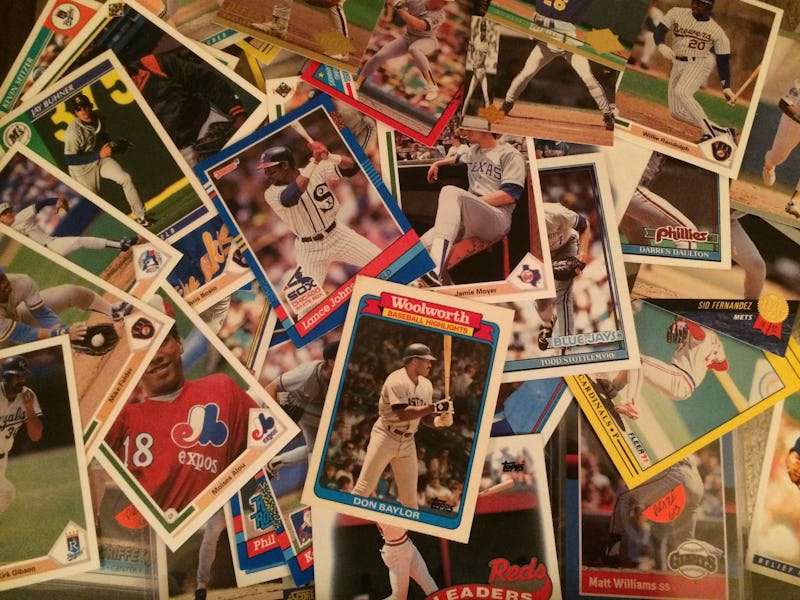What the Hell Should I Do With My Massive Baseball Card Collection?
If you grew up in the 1990s, they're probably worth less than your VHS tapes.

A couple of weekends ago, I took a trip to Bill’s Sports Collectibles, a boyhood hangout of mine situated in a south Denver strip mall. I was a proud part of the baseball card bubble, collecting nearly from my birth in 1983 until the early 2000s. Going to Bill’s, playing card shows, and trading with my friends was like breathing sweet, sweet oxygen. I have heaps of cards from that era — filling everything from old wine boxes to carefully organized binders. Some were worth hundreds of dollars back in the day. Now: not so much. So, what should I do with them?
When I was growing up, my father spun yarns about how my grandmother threw away his baseball card collection. He had a Babe Ruth, he says! Stories like these are legend — no, he never claimed Woodstock attendance — and might be part of the reason that many from my generation haven’t thrown their collections away. (That and the fact that my borderline-hoarder mother clings even to decayed vegetables before she eventually pitches them.) I went to the basement of my childhood home to brush the dust off of them and see what I’ve got.
Maybe there's a T206 Honus Wagner in here.
At Bill’s, I picked up the December 2015 edition of Beckett Baseball. The monthly magazine breaks down the value of cards; it used to be my bible. I would crack open a Beckett and see if a Bo Jackson or Greg Maddux card in my possession had increased in price. (The funny thing is, of course, I never had any intention of selling.) After finding out that the industry’s sales plummeted from $1.5 billion in 1992 to $200 million by 2012 — taking plenty of brands and shops with it — I was kind of surprised to find that Beckett is still in publication. I opened it up to see what some of my prize possessions were fetching. All values are for mint condition:
Score, 1990, complete set - $15
Score, 1993, complete set - $40
Fleer, 1989, Ken Griffey, Jr. (rookie card) - $10
Upper Deck, 1991, Michael Jordan (White Sox baseball card) - $8
These baseball cards used to make me very happy. Now they make me sad.
Yikes. The only cards of consequential value now are old or have errors — kinda like stamps. I know I have a Yogi Berra and a Duke Snider somewhere, but even they aren’t getting me a down payment for a new house. A 1959 Topps Willie Mays, for example, will bring in all of $175 in 2015. I remember the Upper Deck Ken Griffey Jr. rookie card being a collector’s must-have back in the day, but I never got it because it was too expensive. How much is it worth today? Forty bucks.
I couldn’t find an old Beckett to compare what my cards would’ve been worth at peak value, but I did discover a book on my shelf, Start Collecting Baseball Cards. Printed in 1989, it’s aimed at kids getting in on the game, and it’s hilarious and wonderful. It also contains some 1989 pricing. “The cost of the 1984 Fleer set is near $100,” author David Plaut writes. “And should continue to appreciate rapidly.” Its cost today? $50.
Some of the way-old cards have appreciated in value, while the 1980s and 1990s have really taken it on the chin. Scanning the Beckett, most of my cards are worth cents, not dollars — a sure sign of overproduction. Every kid in America had these cards, and slipped ‘em under lucite, so they’re basically worthless now. Veteran card collectors will tell you, too, that a generational shift took place when moms got savvy to the potential value of cards. When kids these days went off to college, their parents didn’t drive down the overall supply by sending cards to the landfill along with old toys and sun-faded posters.
I see you Chuck Knoblauch!
Yet some of the newer sets have real value, probably because not many people these days are buying cards. When I spoke to a fellow named Brett, who’s worked at Bill’s for 20 years, I asked him if autographed memorabilia was their top seller. “It’s not cards,” he said, dryly. “It’s nothing like it used to be.” When I asked him if the card-collecting industry was making a comeback, he shook his head. “It’s still really soft. Kids today have better things to spend their money on or would rather spend their money on,” Brett said. “And baby boomers who used to buy a lot of the cards are getting to the age where they want to downsize instead of adding to their clutter.”
So, what to do? Inside the new Beckett, its editorial director Mike Payne offered some words under a column entitled, “Changing Landscape.” “So much has changed, yet so much remains the same: Rookie Cards, certified autograph cards and serial numbered cards are still very much the backbone of the trading card industry,” he writes. Okay, so burn the rest? Well, kinda. There’s no way your Topps 1991 Bruce Ruffin will be worth much. But, cards for Hall-of-Famers — especially when they were rookies — will always be worth keeping. The more that our generation throws these cards away, the less there will be in the market. Less supply could equal more demand. I’ll call it my 2055 retirement plan. Maybe they’ll be worth a ticket to the ballgame.